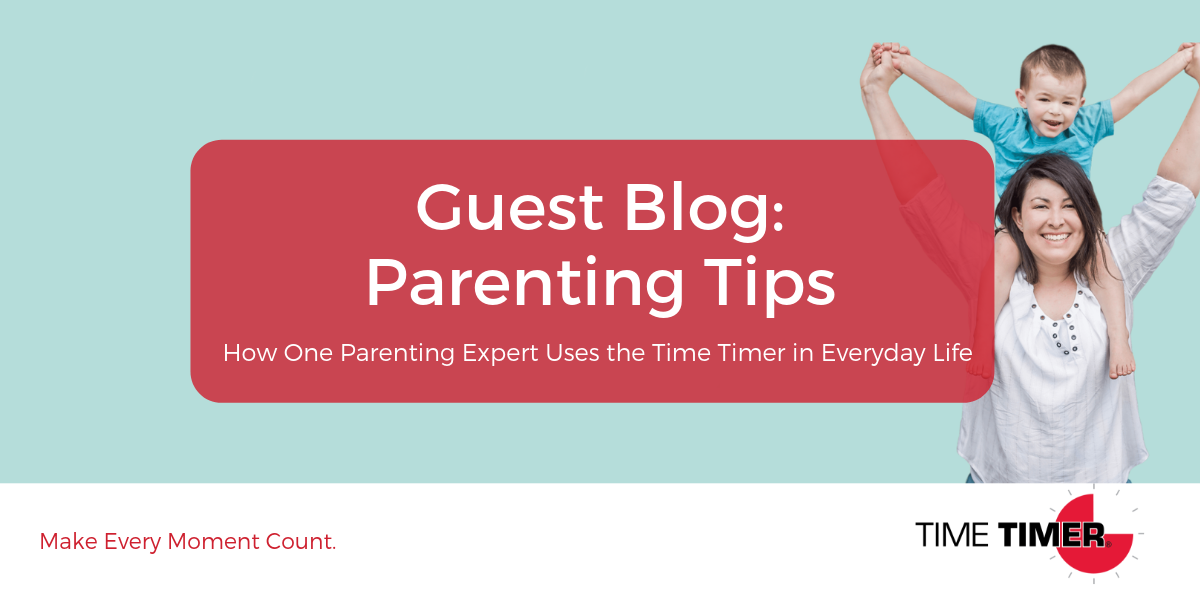Allana Robinson is a Parenting Effectiveness Coach in Western Canada and runs Uncommon Sense Parenting, the Parenting Posse Facebook group, and publishes the Mud Room Blog.
Allana spent a decade working with children with Special Needs as an Early Childhood Educator and Developmental Specialist, and has spent countless hours researching and creating targeted behavior intervention plans.
As a parenting coach for infants, toddlers and preschoolers, Allana talks about all the ways Time Timers have helped in her life and the lives of her clients.
We thought you might enjoy reading her thoughts and all the different ideas she has for using the Time Timer!
LET’S TALK ABOUT TIME TIMERS!
By Allana Robinson
We’ve had a LOT of Posse members sharing wins lately using timers and every time someone does we get lots of questions about why use a timer, what kind of timer, “I thought we didn’t do timed turns,” etc. So, I figured - let’s talk about why timers - specifically Time Timers - are awesome and in what scenarios we’d use them.
When you set the Time Timer, the amount of time that you’ve set gets coloured. And as the time reduces, so too does the colour. It’s completely analogue, but it’s really cool.  The difference between the black and red one and this blue and white one are the different lengths of time. The black and red one is an hour-long timer. The white and blue one is a 20-minute timer. There’s also a 5 minute and 120-minute version of these that are green and dark blue and white respectively.
The difference between the black and red one and this blue and white one are the different lengths of time. The black and red one is an hour-long timer. The white and blue one is a 20-minute timer. There’s also a 5 minute and 120-minute version of these that are green and dark blue and white respectively.
So why the Plus? What’s so special about these timers in particular?
The Time Timer Plus has a hard face to it. So little hands can’t get in at the disk and rip or pull on it. It’s set by a dial in the middle that is super smooth to turn. It has a handle - which seems completely gratuitous until you’re literally carrying it everywhere with you. It has sturdy little feet that allow it to sit on a table top. And at the back, the battery compartment is screwed shut - which believe me, is a feature you want. And it has this handy beep volume control at the back which is AWESOME for when you’re in public. Sometimes you’re on an airplane or in a restaurant and EVERYONE AROUND YOU doesn’t need to hear your child’s timer going off. So you can make it quiet.
So that’s it for the features of MY personal favourite timer. There’s also a Time Timer app, which is pretty cool, but I don’t like using it unless my kids really catch me with my pants down because then I lose access to my phone while they use it as a timer.
When do we USE these timers? What are the instances they are helpful with?
Time Timers are fantastic for making time concrete for children. Time is really abstract for little kids and it’s really difficult for them to understand what exactly 5 minutes means. Their sense of time is really poor.
You know how when you’re doing something you really enjoy 5 minutes seems to disappear in a snap, but when you’re waiting for a doctor and you’re in one of those paper gowns it feels like FOREVER? Yeah- same for kids. If you’re asking them to do something in 5 minutes and they’re engaged in something really motivating- OF COURSE they’re going to melt down when you say 5 minutes is up because it felt like TWO SECONDS to them. On the flip side, if they’re having to endure something that’s non-preferred - it can feel like there is LITERALLY no end in sight and they’re going to be stuck doing this horrible thing forever.
As adults, we can tell time, we have cell phones with clocks on them. We can monitor our time. But little kids can’t tell time. They’re still figuring out number ordinance. And relating it to a length of time is WAY ahead of the average toddler or preschooler’s development. So by making it visual like this - you make it concrete without relying on skills they don’t have.
Most kids in the preoperational stage of development- and if that wasn’t a term familiar to you - go back and check out the MudRoom we did on Jean Piaget… about a year ago. But preoperational kids relate big to long and small to short - they conflate size and quantity. If they see four cookies in a stack and four cookies spread out on a table, they’ll take the four in the stack because of big means more to them. So we can use that to our advantage - and the Time Timer does EXACTLY that. The bigger the red, the more time I have. The smaller, the less. It makes sense to preoperational children.
My timers are almost fused to my hand. The red one generally lives in my playroom because I’m teaching my younger son to play totally independently now. He’s pretty good at playing with my older son - but when he’s alone he’s not so good at it. But if I just stick him in the playroom and say “Okay I’m going to do laundry and you play” - he’ll cry at the gate the ENTIRE TIME because I could literally be doing laundry for hours - he has no idea. BUT - if I set this for an hour he can see how long he’s going to be in the playroom, he can SEE that the time is diminishing, and he trusts that when it beeps I’m going to come to get him.
Now, that’s one limitation of the timer - you have to build trust in it. If I tell my kids something is going to happen when the timer beeps - you bet it’s happening. Because I want them to trust it. So, he happily goes in the playroom and plays for an hour because he knows this isn’t going to last forever - Mommy will come to get me when it beeps.
I’ve used them to keep my son in the pool for swimming lessons. My older one refused to stay in the pool - I wasn’t even making him participate - my limit was just staying in the pool for the class. But he kept getting out… so I pulled out the timer and said, “You need to stay in the pool until the red is gone.” And I set it for 45 minutes and he did!
I use it to warn kids that something they like is ending. We go to this bouncy house place and when I want to hit the road in 20 minutes I whip out my timer and say “HEY! We have 20 minutes until we leave, okay?” and both of them look at it and go “okay!” and then I sit it on the table and you occasionally see their heads pop out to look at it… but when it beeps, they come running.
We set the blue 20 minute one for two minutes for teeth brushing. Everybody brushes for two minutes. No fuss.
They clean up their rooms because they know they have 30 minutes to do it and if it’s not done we can’t do… whatever motivating thing we’re going to do after, like go swimming or to the park.
I set it when my youngest wakes up from his nap to show him there’s an hour until we can leave to go get my oldest off the bus or else ALL I HEAR for that hour is “Gogie BUS STOP!?” Which is really cute for the first day and ANNOYING for the rest of time. So now he can see how much time he has until his brother gets home.
ANY TIME we need to do something in a certain amount of time, stop something, or wait for something - I use the timer.
This takes us out of the role of the nagger, it helps them develop their self-monitoring, and it holds BOTH of us accountable. If I say they have five minutes - they have five minutes. They can see that. If they say they’re going to do something FOR five minutes - they have to do it in five minutes.
I give one of these to every new Mom. It’s my standard baby shower gift: Time Timer, a package of Depends, and tucks pads. It is NEVER the most popular or ooo’d over gift at the time, but you best believe my friends are calling me post-birth and when their child is 2 going “OMG, you’re the only one who really loves me.” And it’s true - adorable onesies only get worn a few times. The gift of a timer lasts forever.
This is an edited version of Allana Robinson’s blog post, originally appearing on the Mud Room Blog on October 14, 2018. View the blog post in its entirety, as well as a video version of the post here.

